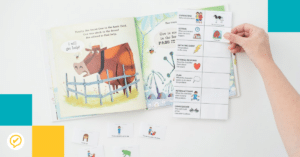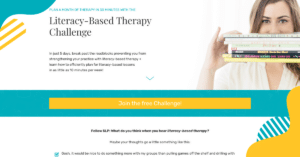Listen on Apple Podcasts Listen on Spotify
This Week’s Episode: Targeting Grammar Goals with Literacy-Based Therapy: Later Elementary
So far in this month’s podcast series we’ve targeted MLU goals with our preschoolers and irregular and regular plural nouns with our early elementary students.
This week we are working on compound and complex sentences in Part 3 of our series about targeting grammar goals using literacy-based therapy. 🤓
For this week’s lesson planning we’re going to work with an article from ReadWorks called “The Hiking Trip”, which is an article about a boy who’s really looking forward to a hike with his dad. It’s finally springtime, the snow has melted, and they head out for their hike — inevitably encountering some obstacles to overcome along the way.
What I really like about this article is that it does come with a written and audio version, which is great for teletherapy — we can send the link to our students, and they can either read or listen to it at home to get additional exposures. 💪
It’s worth mentioning that when it comes to therapy planning, I usually count on spending about a month on each book unit — depending on the students’ needs and where they’re at — so I like to have a variety of activities that I can draw from.
I plan it all up front and then get to cruise through the rest of the month in observe + adjust mode. 😎
That gives us plenty of time for meaningful embedded practice of all the different skills, and we have the chance to see our students really make some progress on their goals.
Let’s put on our planning pants and get to work! 👖
Here’s what we discussed:
[4:15] Therapy Ideas for Step 1 (Pre-Story Knowledge Activation)
[8:15] Therapy Ideas for Step 2 (Reading)
[9:30 Therapy Ideas for Step 3 (Post Story Comprehension)
[11:45] Therapy Ideas for Step 4 (Skill Practice)
[13:15] Therapy Ideas for Step 5 (Parallel Story)
Want to hear more about this topic? Click here to see this month’s content!
Strategies + Tips Discussed
– Recasting / Modeling / Cued Combining / Open Combing
– Tip 1: Use keyboard shortcuts to highlight specific conjunctions in the article. (Command + F) for Mac or (Control + F) for PC
– Tip 2: Use the acronym FANBOYS to help your students remember conjunctions.
Reference
– Strong, W. (1986). Creative approaches to sentence combining. ERIC Clearinghouse on Reading and Communication Skills.
Links Mentioned
– SLP Now Membership (This is where you can find the graphic organizer we mentioned!)
– The SLP Now One-Page Literacy-Based Therapy Unit Planner
– ReadWorks Article: The Hiking Trip
– EdPuzzle
Subscribe & Review in iTunes
Are you subscribed to the podcast? If you’re not, subscribe today to get the latest episodes sent directly to you! Click here to make your listening experience auto-magic and as easy as possible.
Bonus points if you leave us a review over on iTunes → Those reviews help other SLPs find the podcast, and I love reading your feedback! Just click here to review, select “Ratings and Reviews,” “Write a Review,” and let me know what your favorite part of the podcast is.
Thanks so much!
Transcript
Speaker 1: Let's dive into some plans for later elementary, and just a reminder, we are focusing on specific grammar goals for this series of episodes. For this age group, we are focusing on producing compound and complex sentences. A compound sentence uses conjunctions like "and, but, so." Our FANBOYS is the nice little acronym there. Then, complex sentences use the other types of conjunctions like "before" and "because." Then for the article that we're using, it's from Read Works, and it's called the hiking trip, and it's an article about a boy who's desperately looking forward to a hike with his dad. It's finally springtime, the snow has melted, and they finally get to go hiking, and the story has some nice problems along the way as they go on their hike. The cool thing about this reading passage, too, is that read works also provides an audio version of the story, or ... Yeah, and it's a fiction article, so it's got the nice story, grammar elements and all of that good stuff.
It's nice too, especially if we're doing teletherapy, we can send the article to our students and have them listen to it for practice at home, or if they have some center time in the classroom, it's something that they can listen to, just to get additional exposures to it. But now let's dive into the actual plans.
Again, the article that we're using is The Hiking Trip, and we're focusing on compound and complex sentences. These are definitely not all of the grammar goals that we would target with this age group, but these are the ... We came up with a massive list of grammar goals, and definitely check out the show notes for all of the episodes this month to see a list of the goals for the different age groups, but we just generated that list and split it up roughly based on the age group that would be appropriate.
If compound and complex sentences doesn't target the goals that you need, you can check out the episodes for other types of goals, for additional evidence-based strategies, and ideas to target those goals. It will be using a different type of text, but the strategies will still apply. Then again, as always, we're using Dr. [Ukranitz's 00:02:47] five step literacy-based therapy framework, and step one is pre-story knowledge. We are doing a variety of language activities. These are more general activities, but we can be very strategic in how we set up these activities. If the students are new, if it's a new target for our students and they're not able to produce compound and complex sentences on their own, this is a really great opportunity to provide models and to recast their sentences, just to give them exposure. If the student produces two simple sentences, we can recast that, combine the sentence into a compound or complex sentence, whatever their target is, and just give them lots of meaningful exposure. Then in our own speaking, we can produce those compound and complex sentences, and we can also do activities like identifying them in the story and all of that good stuff. The story will include lots of compound and complex sentences.
Then, our book guide for the article actually lists all of the conjunctions that are used, so the coordinating and subordinating conjunctions. We use coordinating conjunctions to create compound sentences and subordinating conjunctions to create compound complex sentences. If you're wondering which types of sentences or which words to look out for, or which conjunctions to look out for, the cheat sheet for the unit will be a great resource for you. That's what we've got just in terms of targets and strategies for the pre-story knowledge.
In terms of the actual activities, we can do an article walk. We can pull up the article, take a look at Read Works includes a picture for this article, so we can look at the picture. We can look at the title. We can maybe look at some of the sentences in the article, and depending on the students' response to this activity, if it seems like they're really missing some knowledge about hiking or the forest, if they've never experienced that, we might take a virtual field trip. I like pulling up videos on Ed Puzzle, and so we can maybe find a quick little video about where a kid talks about a hike that he went on, or they take us on a hike or a tour of the forest, for example. We can just do that if the students need additional background knowledge, and we can use our clinical judgment to decide which type of video would make the most sense for our particular group of students.
Then, another thing that we can do is, if they have that background knowledge, we can fill in the graphic organizer, because this is a story. We can use a story grammar organizer to make a guess, who are the characters, where and when does the story happen? We can just go through the organizer and fill in those pieces and make some inferences. Again, this is a language activity, so we can model and recast the target sentence structures. Another activity that tends to be appropriate for this age group is pre-teaching vocabulary. Again, this is another language activity and we can, again, model and recast the sentence structures as we go through those vocabulary activities. Then, next month we are focusing our all on vocabulary, so definitely stay tuned and listen into those episodes if you want more pre-story knowledge activation, vocabulary activity ideas.
Now we're diving into step two, which is shared reading. With this, we keep it pretty simple. We just read the story. We can emphasize the compound and complex sentences in this story. We can maybe even have the students identify them, or if we just want to make sure that we're emphasizing them as we read, we can pick a conjunction. If we're reading this on the computer, you can do command F or control F, depending on if you're on a Mac or a PC, and it'll highlight all of the conjunctions. If we're using a conjunction like and, it can be an activity to decide if it's a compound sentence or not, because "and" is often used in sentences that are not compound sentences. That can be a great activity in and of itself. But if it's a less common conjunction, that can be a really great way to emphasize those structures, or we can go ahead and highlight them ahead of time, and that's pretty easy if you have the list of conjunctions already in the article like we do for you. That is step two.
Then for step three, we dive into story comprehension. One activity that I like to do is just to ask literal and inferential questions, and as students respond to those questions, I can either ... Well, other students in the group might be modeling the use of compound and complex sentences, and we can emphasize that, or we can recast the students' responses. If the students are a little bit further ahead, if they've been introduced to compound and complex sentences, they've been working on this skill for a while and they're ready to step things up, but they're not at the level of producing these structures independently, we can use an evidence-based strategy called combining sentences. Strong 1986 has a really great article that dives into more detail on this strategy, but this is when ... Let's say a student responds to a literal or inferential question and they give two simple sentences. We can use the combining sentence strategy to have the students combine them to create a single longer sentences.
If we're focusing on compound or complex sentences, we can have them use a specific conjunction. There's two ways that we can combine sentences. We can do cued combining, where I underlined the components in the sentence and/or I can give the student a conjunction to use. If you want more detail on that, you can check out the Strong 1986 article, or we dive into a little bit of that in our grammar course in the SLP Now Academy.
The second strategy that we can use the combining sentence strategy is open combining. This is when I don't give specific instructions and the student can just determine their own way to combine the sentence. I would just give them their two sentences and they get to decide how to combine that sentence. The cued combining and open combining are two strategies that we can use to target those compound and complex sentence schools.
One example that I gave for step three, story comprehension, was filling in those literal and inferential questions. We can also use the same activity with story grammar. We can have students fill in the story grammar organizer, and so they're identifying the characters, the setting, all of the different story grammar elements. Then again, we can have them combine the sentences to produce compound or complex sentences. Then, again depending on where the student is, we can provide models and recast, or we can have them actually do that cued or open combining. We can be use our clinical judgment to decide which strategy makes the most sense.
Then we've got step four, and this is focused skill activities, and we can introduce or review the skills. Inside the SLP Now membership, we have visuals to introduce these skills. Before we have students do the cued and open combining, we would want to introduce them to what a compound sentence is, or what a complex sentences, and just introduce the skill, present that visual, and do a little bit of structured practice with it. When I introduce the skill and I put together the mini lesson, I like to walk through the visual and just explain what it is, what a compound sentence is, what a complex sentence is, and then we create some simple sentences just about the student, something that's high interest that they definitely understand. Then we move from there.
Then again, we can continue using the strategies of modeling, recasting, open combining, cued combining, whatever combination makes the most sense for the particular student throughout any other language activities that we might use. We are targeting a variety of goals with our students. One student might have grammar, vocabulary, story retell, whatever they're working on. We can continue to target the grammar structures throughout the unit.
Then for step five, we would create a parallel story. I would just take the graphic organizer that they filled in before, create a nice blank copy, and then we would create sentences, again trying to elicit those structures, and then we would just create our own story. Maybe they can create a parallel story about a time that they went hiking, or they can come up ... Make a story about another student and make up a problem that they encounter on a hike. The students, especially the older students, have a really great time with that type of activity.
Then again, as we're filling in the graphic organizer, as we're creating that story, we're targeting those compound and complex sentences, encouraging the students to combine them, whether we're using cued or open combining, and that gives them tons of meaningful embedded practice of all of these different skills, and we're really able to see them make some really nice progress on these goals, and it's really simple to put together. We just need the article, a couple of visuals, and just these evidence-based strategies in our packets, and we've got an awesome unit. I hope that was super helpful, and we'll see you next week as we dive into some examples for later elementary.
Sign up to receive email updates
Enter your name and email address below and I'll send you periodic updates about the podcast.




Reader Interactions